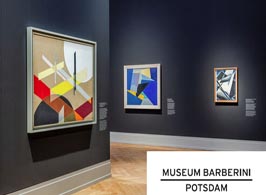
"Kandinsky’s Universe: Geometric Abstraction in the 20th Century" is the first exhibition in Europe to tell the story of geometric abstraction not by presenting a series of national movements, but by tracing the lines of connection between them. Twelve works by Wassily Kandinsky—a key figure in abstraction who influenced generations of artists with theoretical writings such as Point and Line to Plane—serve as a thread running through the exhibition. A total of 125 paintings, sculptures, and installations by seventy artists show how geometric abstraction challenged the imagination of viewers again and again. The artists represented include Josef Albers, Sonia Delaunay, Barbara Hepworth, El Lissitzky, Kasimir Malevich, Agnes Martin, Piet Mondrian, Bridget Riley, Frank Stella, and Victor Vasarely.
At the beginning of the 20th century, painting underwent a profound transformation. Artists no longer wanted to depict the visible; they aspired to a new visual language that reduced artistic expression to an interplay of colors, lines, and shapes. Geometric Abstraction viewed these elements as a visual language that reflected the modern world and transcended national boundaries. Kandinsky’s Universe: Geometric Abstraction in the 20th Century spans six decades and showcases how Geometric Abstraction found radical expression in all its variations in Europe and the USA.
Inspired by the advanced technologies and theories of their time, including concepts of the fourth dimension and the space-time continuum, artists expanded their understanding of space and time. With images of geometric shapes floating in indefinite space, they sought to represent cosmic themes and higher spiritual levels. A central figure of this art movement was Wassily Kandinsky, who laid the theoretical foundations with his work Point and Line to Plane.
Wassily Kandinsky (1866–1944) was one of the first painters to explore abstraction. By tracing the stations of his life and the different phases of his abstract oeuvre, the eight chapters of the exhibition Kandinsky’s Universe survey the most important stages of geometric abstraction.
“The title Kandinsky’s Universe is an apt description of our concept: it refers first of all to the incredibly diverse artistic environment in which Kandinsky worked and which he decisively influenced throughout his life. After Kandinsky’s death in 1944, European exiles brought his ideas to the United States, where Hard Edge painting and Optical Art emerged. But all of these currents also shared an intense interest in the use of painterly means to represent space. Artists were fascinated by the scientific and technological discoveries of their day, and they wanted their art to express new experiences of space and time. In this respect, too, Kandinsky was a pioneer.” - Sterre Barentsen, Curator
The exhibition features 125 works by over seventy artists, including Josef Albers, Sonia Delaunay, Barbara Hepworth, Wassily Kandinsky, El Lissitzky, Agnes Martin, Piet Mondrian, Bridget Riley, Frank Stella, and Victor Vasarely. The more than thirty international lenders include the Courtauld Gallery in London, the Whitney Museum of American Art and the Solomon R. Guggenheim Museum in New York, the National Gallery of Art in Washington, the Fondation Beyeler near Basel, the Fondation Gandur pour l‘Art in Genève, and the Peggy Guggenheim Collection in Venice.
HFA artists include:
Cesar DOMELA
Auguste HERBIN
Jean LEPPIEN
Aurelie NEMOURS
Sophie TAEUBER-ARP
